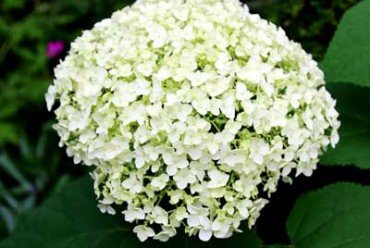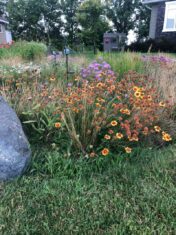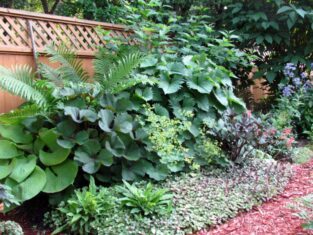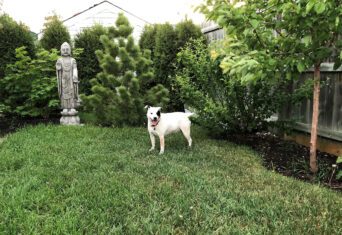
My ‘Annabelle’ hydrangea (Hydrangea arborescens ‘Annabelle’, 4 x 4 ft. / 120 x 120 cm, Zone 4) is developing broad domes of creamy white flowers. ‘Annabelle’ is a cultivar of the native smooth hydrangea, and woody plant expert Michael Dirr makes a “beauty and the beast” comparison between ‘Annabelle’ with its huge and long-lasting flowers, and its species ancestor with small flowers appearing for just three weeks in June. The flower domes on ‘Annabelle’ are so heavy that the stems on the perimeter sometimes need staking. I’m only too willing to provide occasional staking, considering that one blossom fills a small vase, and three positively overwhelm a crystal bowl.
There is a warm pink version of ‘Annabelle’ called Invincibelle Spirit hydrangea (H. arborescens ‘NCHA1’, Zone 4) that pumps out flowers in great abundance. A new hybrid improvement (if you want to think of it that way) is Incrediball hydrangea (H. arborescens ‘Abetwo’, Zone 5), with stronger, non-flopping stems and – gasp! – flowerheads up to four times larger than ‘Annabelle’. I’m not sure my sensibilities could stand the shock of such a big flower.
In early spring, cut down the stems of all H. arborescens cultivars to about 10 inches (25 cm) above ground; they’ll sprout new wood to carry the season’s flowers.
The choice in hydrangeas grows more enticing each year. My old favourite, Peegee hydrangea (Hydrangea paniculata ‘Grandiflora’, 7 x 8 ft. / 2 x 2.5 m, Zone 5), makes permanent woody stems (only light pruning is required to shape the shrub) that carry large, cone-shaped white flowers changing to pink and bronze in autumn. These can be cut for indoor dry flower arrangements, lasting all winter. After a couple of decades, Peegee hydrangea can grow into a large, gorgeous old specimen. Now there is a dwarf version, ‘Bombshell’ (H. paniculata ‘Bombshell’, 40 in. x 5 ft. / 1 m x 1.5 m, Zone 5). ‘Bombshell’ has a tight shape requiring infrequent pruning, and blooms early with masses of flowers that could be described as smothering the shrub.
Of course, plant breeders continue to be in love with the colour pink, and now we have—yes, really—Pinky Winky (H. paniculata ‘DVP Pinky’, 7 x 8 ft. / 2 x 2.5 m, Zone 5) with white flower cones turning to deep pink as summer advances, held upright on red stems. There is also Mystical Flame hydrangea (H. paniculata ‘Bokratorch’, 5 x 5 ft. / 1.5 x 1.5 m, Zone 6), another early-blooming hydrangea with loose, white cone-shaped flowers turning burgundy as the season progresses. Its cousin, Quick Fire hydrangea (H. paniculata ‘Bulk’, 7 x 7 ft. / 2 x 2 m, Zone 5), has similar characteristics, but is hardier.
I’ve only scratched the surface of hydrangeas we can grow in a northern climate, and will return to this discussion again. After all, I haven’t mentioned the whole business of what makes hydrangeas blue or pink, and I have a few more favourites to share.
Spot watering schedule
I don’t like to be a nag about this, but we really do need to be thinking about areas of the garden that are running seriously dry. Of course, after such an incessantly soggy spring, it’s understandable to think the rainwater was sufficient for a long time. But it wasn’t. It’s all drained away or evaporated, and now there are seriously dry conditions in planting beds.
I’ve been hauling the hoses around and giving long, deep drinks to woody plants and perennial beds. I use a circular water breaker, an inexpensive plastic ring-shaped device with many holes in it, creating a Versailles-style circular fountain. I set this in perennial beds to soak them for an hour, moving the ring about to be sure of complete coverage. For shrubs, garden trees and boulevard trees (yes, we absolutely must water them), I set the ring at their feet and then turn it upside down so that the many water jets shoot directly into the ground. I move it from one side of the plant to another for about 20 minutes on each side, and slow the water flow to prevent pooling and run off. This delivers a deep watering that lasts for a week.
My front lawn is new, grown from seed this spring, and the young grass blades are still a bit tender. I use a whirligig spinning device (another inexpensive hardware store item) to shoot out a drenching rain of water, delivered at night, and run it twice a week for an hour in each location to get full coverage. The back lawn purposely has more clover than grass in it, making it considerably drought hardy, and I’ll be adding clover seed to the new front lawn next spring. This week I’ll give the back lawn some water, the first time I’ve irrigated it this season.
Last on my irrigation schedule are areas that have gone wild or are damaged (from neighbouring construction). Although these areas are in disrepair, it’s important to maintain the integrity of the soil by providing moisture. If allowed to go deeply dry, they will be much harder to rehabilitate when things finally settle down around here.
Whatever watering device you use, have a look at the washer next to the threads where it screws onto the hose. Washer rings are made from various pliable materials, usually vinyl or rubber, and serve to make a tight seal between the device and the hose, preventing leakage. There are also differences in shape—round washers and flat washers. It’s my experience that flat rubber washers make a superior seal, and end the problem of water escaping the hose and forming pools under the watering device. You can purchase them from hardware stores or online garden tool companies, and they should be changed every year or two. I try to get all my watering devices out and change the washers in early spring, as I’m getting tools ready for use.









I have a hydrangea that is about 30 cm tall, 50 cm around and about 5 years old. It is planted in full sun. It appears to be very health. The plant has never flowered. Any ideas as to why?
Henry O’Keefe
Welland, Ontario
Wonderful post on the growing and care of Hydrangeas <|;-)